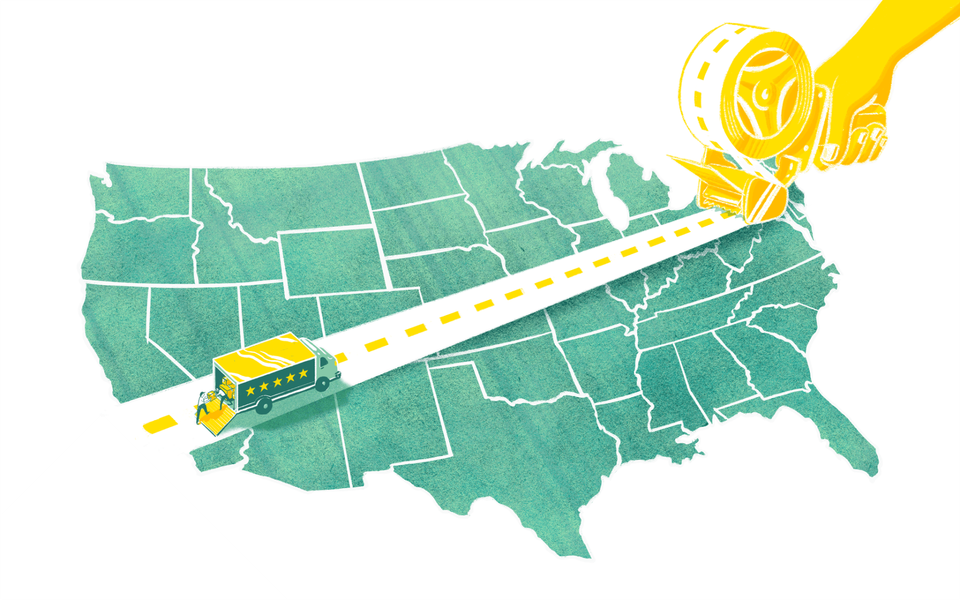Hire Interstate Movers Without Getting Scammed
Hire Interstate Movers Without Getting Scammed
Each year, about 3 million people in the U.S. move across state lines. While moving is never easy, the company you hire can make that transition smooth — or a nightmare. Last year, the National Consumer Complaint Database
received more than 4,000 complaints from consumers for everything from a delayed delivery to having their goods held hostage by their movers.
So, if you’re planning to move across the country (or even just across a bridge to a new state), take these steps to hire movers who can do the job, get your belongings there safely — and not rip you off in the process.

Research your moving options
Start your search as soon as you know you’ll be moving. Ideally you can book your shippers at least 30 days in advance, while some companies will let you do it as early as 90 days ahead of time. Your first line of defense is to ask around for recommendations from friends, family and colleagues.
If you don’t know anyone who has moved recently, skip the Google search (it’s easy for bad actors to pull together a reputable-looking site) and look up house movers on the Better Business Bureau
site, where they’re rated on a number of factors, including complaints and legal action against the company. You can also check out reviews on Yelp, but as always, take those with a gain of salt. As you start your search, get familiar with the terms
you’ll hear from moving companies — for many, it’s an all-new vocabulary, including phrases like the bill of lading, which is the receipt for your goods and contract for their transportation.
Vet the moving companies
Once you have a list of recommendations, look deeper into each one. You will need the company’s name, its U.S. Department of Transportation (D.O.T.) number and its Motor Carrier (M.C.) number. If they’re missing either number, cross them off the list — it means they’re not licensed to move property across state lines.
Search the company using their M.C. number or D.O.T. number at the Federal Motor Carrier Safety Administration’s website. The results will show you whether the company is a carrier, broker or freight forwarder. A carrier is a company that you hire directly to move your goods, while a broker will hire a carrier for you, usually for a fee. A freight forwarder takes responsibility for your goods, but will use one or more carriers to move them, sometimes consolidating smaller moves into one larger truckload.
Beyond understanding what kind of company you’re using, the safety administration website will give you the company’s most recent safety rating and insurance data, as well as the number and type of complaints that have been filed against the company in recent years. There are 14 different complaint categories, including loss and damage, weight disputes and holding goods hostage. While it’s common for a company to have a few complaints, beware of numerous complaints about delays in delivery and repeated loss and damage claims
Get in-person estimates
Call three to five companies for estimates. A reputable company will send a representative to do an on-site inspection.
Anecdotally, I’ve found that it’s hard to get in-person estimates for small moves, like one out of an apartment, so be prepared to call a few more places. Ideally, an in-person estimate will give you a clear idea of how much it will cost to move your things, rather than a vague one based on your number of bedrooms.
When your shipping agent arrives, they are legally obligated to hand you a flyer called Your Rights and Responsibilities When You Move. Then it’s up to you to show them absolutely everything in your home to get the most accurate estimate possible. That includes all the junk stashed under the bed and items outside of your home, like bikes, strollers, garden equipment, and boxes in a basement or off-site storage.
As you go through your home, flag items of extraordinary value, like artwork or antiques, that should be handled differently or insured at a higher rate. Many movers recommend you personally transport items of high personal value, like medical files, photo albums or car keys. And be aware that the mover will not transport hazardous or perishable items, including plants, pantry goods, cleaning supplies and alcohol; they should supply you with a detailed list. You’ll want to use these up, donate them or transport them yourself.
Ask questions
While the agent is taking inventory of your belongings, ask how the estimate will be calculated. Also ask: Are there any base fees, will the total fee be calculated by weight, volume or time, and what do they charge for additional services like packing, transporting your goods up or down stairs, or moving heavy items like appliances or a piano?
Find out if the moving company will have their own movers do the packing and driving, or whether they will subcontract to someone else, and whether your things will have to share a truck with other households. Find out whether you will be a “direct” move, where the same crew loads and unloads your belongings, or an “indirect” one, where your things may switch trucks and moving crews before getting to your new home.
The agent should also explain how your goods can be insured. Released value protection is the minimum standard, which recoups up to 60 cents per pound if something is lost or damaged. Some companies also offer full value protection for an additional fee. Be sure to read the fine print on this insurance to note any exclusions and what the shipper’s idea of “replacement” is — they might repair a damaged item, replace it with a like item, or give you cash to replace it.
Separately, look into your own insurance to see if you’re covered by your renter’s or homeowner’s insurance, and compare that cost to the movers’ coverage.
Review your offers
After the inspection, you will receive a written estimate, which can be binding or nonbinding. A binding estimate means that they cannot charge more or less than the stated amount, unless the mover determines at the time of pickup that there are more items or services than originally estimated. (If this is the case, the movers would revise the estimate on-site for you to sign before packing up). A nonbinding estimate is typically based on weight, and they can charge up to 10 percent more once they get the official weight on your goods after packing them into the vehicle and stopping at a weigh station. You can ask to be present when they weigh the goods.
Book your mover
When comparing estimates, price is the most obvious factor, but take the time to revisit the complaint database
to determine which company has a history of better service. As with many things like this, you may not always want to go with the cheapest option. All things being equal, go with your gut or a friend or partner’s recommendation.
Once you’ve accepted an estimate, you’ll receive an order for service, which will have all the carrier and pickup/drop-off information, as well as terms for payment, insurance and delivery dates. Do not sign any blank or incomplete documents.
Prepare for moving day
As you approach the pickup date, check in with your carrier to confirm the details or make any adjustments in writing. Pack up any items you will be moving yourself, as well as everything you’ll need to live in your new space for up to two weeks before the rest of your household goods arrive.
Plan to supervise the entire pickup, which could take one or more days, and plan to do the same for drop-off. On moving day, you will be handed a bill of lading as well as an inventory list; read them thoroughly before signing and hold on to them to compare at delivery.
For more information on interstate moving, including how to file a complaint if you have a bad experience, visit the Federal Motor Carrier Safety Administration’s Protect Your Move portal.
Ayn-Monique Klahre is a journalist who covers home and lifestyle topics. You can find her at aynmonique.com
or on Instagram: @amklahre
Let An Interstate Moving Broker Take Care Of Finding Reputable Long Distance Movers For You!
Contact Us

You're uprooting your life and moving cross-country. Daunting, isn't it? Worry not, we've got your back. This guide will help you understand the basics of a big move, identify essential packing supplies, pack efficiently, and handle your valuable possessions. Plus, we'll offer tips on unpacking and settling into your new home. Let's demystify this process and make the transition as smooth as possible. After all, it's not just about the destination but the journey, right?









